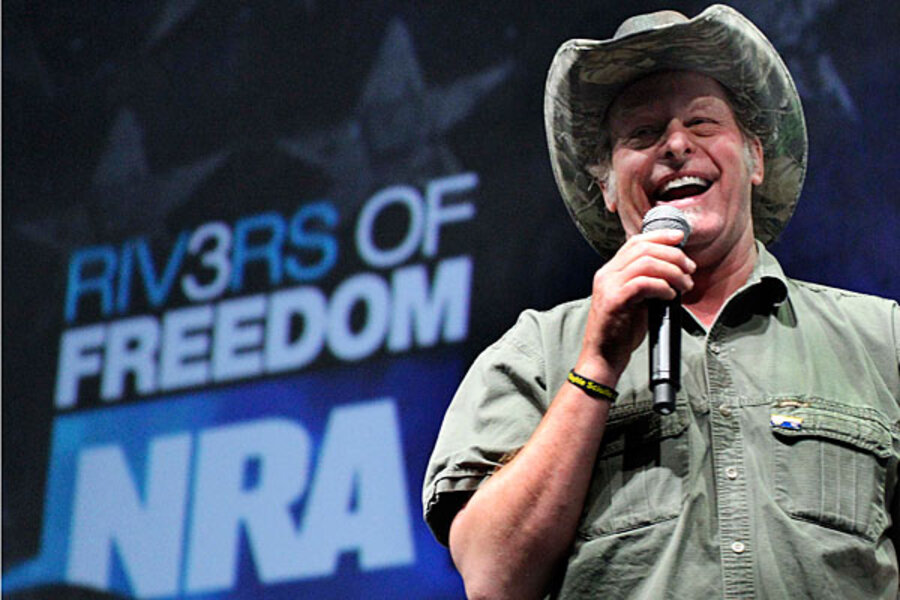Ted Nugent meets Secret Service: Was he singled out?
Loading...
Ted Nugent has met with the Secret Service and there were no explosions of either a literal or metaphorical kind.
The longtime shock rocker met with two “fine, professional” agents in Oklahoma, where he’s scheduled for an evening gig, he said in a statement Thursday afternoon. Mr. Nugent did not barricade himself in his dressing room. The Feds did not haul him away in handcuffs.
Instead they all had a nice chat about Nugent’s recent harsh statements, such as his assertion at last weekend’s National Rifle Association convention that if President Obama is reelected “I will either be dead or in jail by this time next year.” The Secret Service apparently came away convinced that Nugent is only a threat to decorum, not the chief executive of the US.
“The issue has been resolved” and the agency “does not anticipate any further action,” Secret Service spokesman Brian Leary told the Washington Post.
Given how smoothly this confrontation went, we’ve been wondering, was Nugent just singled out for Secret Service attention? Or do agents do this every day, interviewing verbal flamethrowers all across America as their first line of US VIP defense?
We’re guessing the latter. As part of its approach to presidential protection, the Secret Service interviews hundreds of people every year to see if they’re real threats. In that sense, the Nugent meeting wasn’t special – it was just agents doing their usual job.
It has been a crime to threaten the life of the president since 1917, according to a recent Congressional Research Service report on the Secret Service and its mission. While Secret Service officials have indicated there has been no increase in death threats against President Obama as compared with his immediate predecessors, the exact number of serious threats a president receives, and the Secret Service reactions to them, is classified information.
Thus “the extent to which Presidents have been threatened or targeted remains a matter of conjecture,” writes CRS Homeland Security policy analyst Shawn Reese.
However, one can at least get a feel for the scope of this problem from the US Secret Service Annual Report for Fiscal Year 2010, the latest such study available. It notes that in that year the agency “produced more than 450 protective intelligence assessments.”
While those assessments may cover more than just presidential safety, they are a crucial tool for agents trying to sort out real threats from trash talk by attention-seekers.
In the 1990s, the Secret Service conducted a five-year analysis of individuals who had attacked or tried to attack prominent public officials. This Exceptional Case Study Project led to the creation of an in-house National Threat Assessment Center and still guides agents in their approach to protecting national figures today.
One of the study’s key findings was that potential assassins almost always attempted to communicate their intentions in some way prior to acting. Translated, this means agents follow up anything that might be construed as a serious threat. You never know.
“Threats should always be investigated; even if a threat is not an early warning of attack, making a threat is usually a violation of law, which is a valid reason for opening an investigation,” concludes a Secret Service guide to threat assessment investigations for law enforcement officials.
So in that sense Thursday's Ted Nugent meeting was just the same-old, same-old, for agents who’ve done it many times before.
Agents likely asked Nugent if he had ever made plans to attack the president, ever actually tried to get near the president, and so forth. However, in one key respect Nugent would be a very unlikely presidential attacker, according to Secret Service documents. Most real or attempted assassins want to achieve notoriety or fame, or solve some perceived personal problem. Disliking the president’s policies isn’t enough.
“Contrary to the general perception few assassins in the United States – even those targeting major political leaders – have had purely political motives,” says the Secret Service guide to threat assessment.





